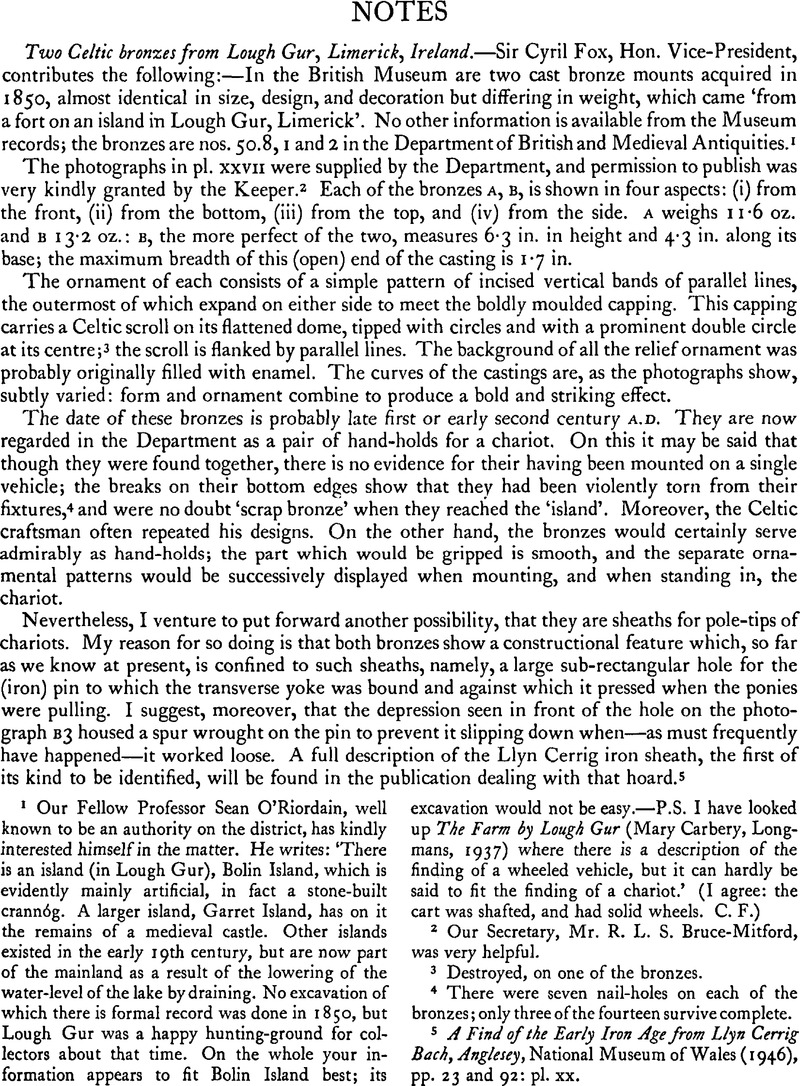Article contents
Two Celtic bronzes from Lough Gur, Limerick, Ireland
Published online by Cambridge University Press: 29 November 2011
Abstract

- Type
- Notes
- Information
- Copyright
- Copyright © The Society of Antiquaries of London 1950
References
page 191 note 1 Our Fellow Professor Sean O'Riordain, well known to be an authority on the district, has kindly interested himself in the matter. He writes: ‘There is an island (in Lough Gur), Bolin Island, which is evidently mainly artificial, in fact a stone-built cranndg. A larger island, Garret Island, has on it the remains of a medieval castle. Other islands existed in the early 19th century, but are now part of the mainland as a result of the lowering of the water-level of the lake by draining. No excavation of which there is formal record was done in 1850, but Lough Gur was a happy hunting-ground for collectors about that time. On the whole your in- formation appears to fit Bolin Island best; its excavation would not be easy.—P.S. I have looked up The Farm by Lough Gur (Mary Carbery, Longmans, 1937Google Scholar) where there is a description of the finding of a wheeled vehicle, but it can hardly be said to fit the finding of a chariot.’ (I agree: the cart was shafted, and had solid wheels. C. F.)
page 191 note 2 Our Secretary, Mr. R. L. S. Bruce-Mitford, was very helpful.
page 191 note 3 Destroyed, on one of the bronzes.
page 191 note 4 There were seven nail-holes on each of the bronzes; only three of the fourteen survive complete.
page 191 note 5 A Find of tie Early Iron Age from Llyn Cerrig Bad, Anglesey, National Museum of Wales (1946), pp. 23 and 92: pl. xxGoogle Scholar.
page 192 note 1 Vol. xxix (1949), pp. 81-3.
page 192 note 2 There are other developments in these fittings, One at least of the known pole-tip sheaths can only have been used for parade. This is the Ist-century A.D. sheath in the Stanwick hoard at the British Museum. It is paper-thin, of golden bronze deco- rated with delicate scroll-work in relief, 2·8 in. long and 1·65 in. wide, but with a hole to carry a heavy pin 1·2×0·34 in. in section.
page 192 note 3 The phallic type here represented—circular shaft, roll, dome, and central ring—is present on the continent in the stone column at ‘Irlich in the district of Koblenz, a region full of Celtic graves In old times the stone was said to be a “Morderstein”, i.e. it gave sanctuary to a murderer who touched it. On the dome [are] the remains of a moulded ring’ (Jacobsthal, , Early Celtic Art, pl. 11, 12 and p. 166)Google Scholar. On pp. 8-9 Jacobsthal remarks: ‘there is positive proof that the stone is Celtic and descended from Etruscan models.… The Celts became acquainted with these tomb phalloi in Etruscanized north Italy.’ A decorated parallel in Ireland is the Turoe stone, County Galway.
page 192 note 4 In Dr. Adolf Mahr's Presidential Address, P.P.S. (1937), p. 405.
page 192 note 5 Loc. cit., p. 411.
- 2
- Cited by




